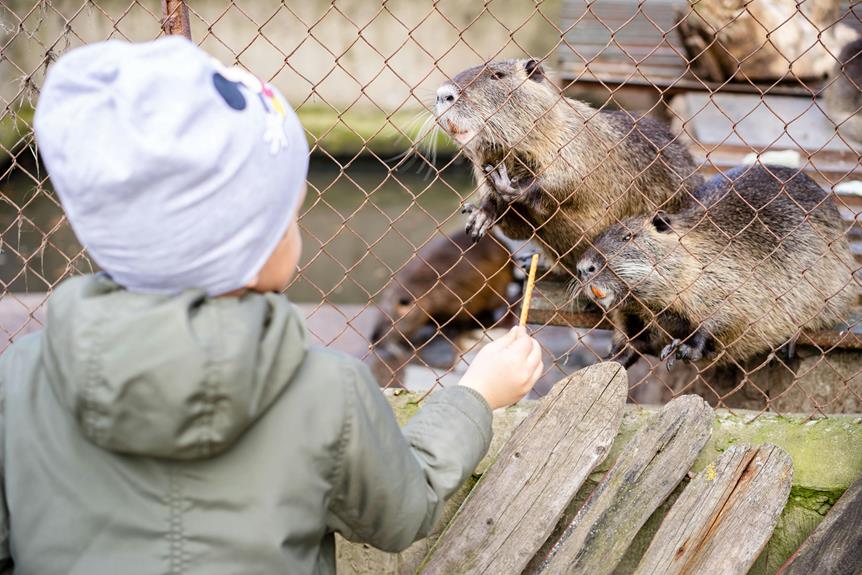
When setting up cages for your small rodents like hamsters and gerbils, make sure to choose soft, absorbent bedding like aspen shavings or paper-based materials. Avoid cedar or pine shavings. Provide at least 360 square inches of floor space for hamsters, add enriching toys like wheels and tunnels, and opt for secure water bottles or heavy ceramic bowls for food and water. Check, clean, and refill stations regularly for their overall well-being and happiness. More insights on creating the best environment await.
Bedding and Nesting Materials
Choose a soft, absorbent bedding material to provide a cozy nest for your small rodent. Opt for materials like aspen shavings, paper-based bedding, or hay. Avoid cedar or pine shavings as they can emit harmful aromatic oils. Bedding should be at least 2-3 inches deep to allow your pet to burrow and create tunnels. Change the bedding regularly to maintain cleanliness and prevent odors.
Ensure the bedding is dust-free to prevent respiratory issues in your small rodent. Avoid using materials like cotton or fabric, as they can pose a risk of entanglement and ingestion. Paper-based bedding is a safe and cozy option that's readily available in pet stores. Monitor your pet's preferences and behaviors to determine the most suitable bedding material for their comfort.
Provide nesting materials such as shredded paper, tissues, or hay to encourage natural nesting behaviors. Your small rodent will enjoy creating a warm and secure nest to rest and sleep in. Check the nest regularly and replenish materials as needed to ensure your pet's comfort and well-being.
Cage Size and Layout
For optimal comfort and well-being, ensure the cage size and layout provide enough space and enrichment for your small rodent. Small rodents like hamsters and gerbils require adequate space to move around, exercise, and exhibit their natural behaviors. The cage should be spacious enough to accommodate essential items such as a wheel, hiding spots, food and water dishes, and a designated bathroom area. A general rule of thumb is to provide at least 360 square inches of floor space for hamsters and 5-10 gallons of space for gerbils.
When considering the layout of the cage, provide multiple levels or platforms for climbing and exploring. Include tunnels, tubes, or ropes to add variety and stimulate their curiosity. Ensure that the cage has proper ventilation and lighting, and place it in a quiet area away from direct sunlight and drafts. Additionally, consider adding a cozy nesting area with suitable bedding materials for your small rodent to rest and feel secure. By creating a well-sized and thoughtfully designed cage, you can promote a healthy and enriching environment for your furry friend.
Enriching Toys and Accessories
To enhance your small rodent's environment, consider incorporating a variety of enriching toys and accessories into their cage setup. Providing stimulating items can help prevent boredom and encourage natural behaviors in your pet. Look for toys that are safe for your specific small rodent, such as hamsters or gerbils, to ensure they can interact with them without risk.
Consider adding items like exercise wheels, tunnels, and climbing structures to promote physical activity and mental stimulation. Hamsters, for example, love running on wheels, while gerbils enjoy burrowing through tunnels. Wooden chew toys are also great for keeping their teeth healthy and providing entertainment.
Additionally, nesting materials like shredded paper or hay can offer comfort and enrichment, allowing your small rodent to build cozy nests. Rotating toys regularly can prevent them from losing interest and keep their environment engaging. Remember to clean and inspect toys frequently to ensure they're in good condition and safe for your furry friend to use.
Proper Food and Water Stations
Consider incorporating designated food and water stations in your small rodent's cage setup to ensure easy access to essential nourishment. Place heavy ceramic bowls or secured water bottles in accessible areas within the cage to prevent tipping and contamination. Opt for shallow dishes to allow your pet easy access to food without difficulty. Ensure the water bottle's sipper tube is at a comfortable height for your small rodent to drink from easily.
Regularly check and refill the food and water stations to provide a constant supply of fresh resources. Clean the bowls and water bottles daily to prevent bacterial growth and keep your pet healthy. Additionally, monitor your small rodent's eating and drinking habits to ensure they're consuming an adequate amount of food and water.
Remember that hydration is crucial for your pet's well-being, so always keep their water station filled with clean, fresh water. By establishing proper food and water stations in your small rodent's cage, you can promote their health and happiness in their home environment.
Conclusion
Overall, creating a comfortable and stimulating environment for small rodents like hamsters and gerbils is essential for their well-being.
By providing the right bedding, cage size, enriching toys, and proper food and water stations, you can ensure that your furry friends are happy and healthy.
Remember to regularly clean and maintain their cage to keep them living their best lives!




